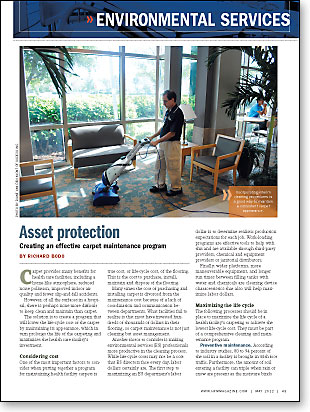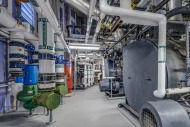 Carpet provides many benefits for health care facilities, including a home-like atmosphere, reduced noise pollution, improved indoor air quality and fewer slip-and-fall accidents.
Carpet provides many benefits for health care facilities, including a home-like atmosphere, reduced noise pollution, improved indoor air quality and fewer slip-and-fall accidents.
However, of all the surfaces in a hospital, there is perhaps none more difficult to keep clean and maintain than carpet.
The solution is to create a program that will lower the life-cycle cost of the carpet by maintaining its appearance, which in turn prolongs the life of the carpeting and maximizes the health care facility's investment.
Considering cost
One of the most important factors to consider when putting together a program for maintaining health facility carpets is true cost, or life-cycle cost, of the flooring. This is the cost to purchase, install, maintain and dispose of the flooring.
Many times the cost of purchasing and installing carpet is divorced from the maintenance cost because of a lack of coordination and communication between departments. What facilities fail to realize is that most have invested hundreds of thousands of dollars in their flooring, so carpet maintenance is not just cleaning but asset management.
Another factor to consider is making environmental services (ES) professionals more productive in the cleaning process. While life-cycle costs may not be a cost that ES directors face every day, labor dollars certainly are. The first step to maximizing an ES department's labor dollar is to determine realistic production expectations for each job. Work-loading programs are effective tools to help with this and are available through third-party providers, chemical and equipment providers or janitorial distributors.
Finally, wider platforms, more maneuverable equipment, and longer run times between filling tanks with water and chemicals are cleaning device characteristics that also will help maximize labor dollars.
Maximizing the life cycle
The following processes should be in place to maximize the life cycle of a health facility's carpeting to achieve the lowest life-cycle cost. They must be part of a comprehensive cleaning and maintenance program.
Preventive maintenance. According to industry studies, 80 to 94 percent of the soil in a facility is brought in with foot traffic. Furthermore, the amount of soil entering a facility can triple when rain or snow are present as the moisture binds the soil to shoes.
While the composition of the soil entering a health care facility will differ from region to region, the bulk of what is tracked in through foot traffic is sandy, gritty particulate. The sand grinds away at whatever it contacts like 120-grit sandpaper. This is why traffic lanes develop in carpet inside doorways and finished floors dull so quickly. They are constantly being ground away by grit being tracked into a facility.
Moreover, soil entering a facility has a direct impact on its environmental footprint. Dry soils drive the maintenance of floors, which in turn drives chemical and water usage and disposal. Furthermore, because the abrasiveness of the soil degrades the appearance of the fiber and reduces the life of the carpet, soil is a major contributor to early disposal and subsequent landfilling.
Sweepers are excellent tools for keeping parking lots and walkways clean and, when employed on a daily basis, dramatically can reduce the amount of soil entering a facility. A small push sweeper or even a small powered sweeper requires minimal investment in either purchase cost or labor costs. Sweeping 50 to 60 feet from a walkway one to three times a day (depending on conditions) can provide tremendous results.
Exterior and interior matting also can be utilized to reduce the amount of soil entering a facility. Most health care facilities have matting; however, many do not have the right type or amount. While the conventional wisdom has been that matting should allow for three or four steps to clean shoes, studies conducted by many matting manufacturers have shown that it takes approximately 30 to 36 feet of matting to remove 99 percent of the soil from shoes.
There also are two different types of mats that should be employed — a ridged scraping mat outside an entrance and a carpet mat inside the facility. The ridged mat scrapes large particulate or debris from shoes into the ridges, preventing it from being carried into the facility by a later footfall. The carpet mat inside the facility wipes and dries shoes, which also helps to reduce slip-and-fall accidents.
Daily maintenance. It is inevitable that some soil will be tracked into a health care facility, no matter how thorough the preventive maintenance plan. That is where daily maintenance begins. Daily maintenance is the process of removing soils that enter a facility so that carpet damage is minimal.
More than any single process, vacuuming is the key to extending the life cycle of carpeting. Dry particulate soil is what scratches and abrades fibers and the most effective way to remove dry particulate soil is by vacuuming.
Additionally, carpet should be vacuumed before any other carpet cleaning process is undertaken, including extraction or encapsulation. No extractor, truck-mounted extractors included, are designed to remove dry soil in a wet, muddy state.
Vacuums should be maintained and adjusted properly. This means that hoses should be free of debris, brushes should be in good working order and vacuum bags should be checked and replaced regularly. To check brushes, ES professionals simply can run a driver's license or credit card along the faceplate on both sides of the brush. If the brush contacts the card, it is in good working order. If not, the brush should be replaced.
To adjust a vacuum, ES professionals should set the dial to the highest height setting, lower the handle into a comfortable position, and then turn the vacuum on. The vacuum then should be adjusted down one setting at a time until the vacuum either begins to pull forward slightly, a change is heard in the pitch of the motor or the dial gets to the lowest setting. Once one of these conditions has been reached, the vacuum is adjusted properly.
High soil-load areas will need an upright vacuum with a brush bar to agitate the soil from the carpet. Whether using a single motor (one that drives the brush and creates the suction) or a dual motor vacuum (one motor that drives the brush and another motor that creates suction), these areas need concentrated
vacuuming.
High soil-load areas will vary by facility but the following are some common areas:
- the first 40 feet inside entries;
- elevators;
- outside restrooms;
- carpeted stairwells;
- areas that transition from hard surface to carpet;
- congregation points like nurses' stations and copiers.
If soil is allowed to accumulate in these areas it not only will damage the carpet, but it will spread further into the facility.
Once the high soil-load areas have been addressed, the focus becomes production rate and what vacuum is the fastest for the area to be cleaned. Choosing the right vacuum for areas with lower soil loads really boils down to which vacuum is right for the space being cleaned. Backpack vacuums are most effective in congested areas such as cubicles and offices, while wide-area vacuums and stand-on vacuums are most effective in open spaces and corridors.
Interim maintenance. The next step is interim maintenance, which maintains the appearance of the carpet while using less chemicals, water, labor and dry time. In the past, this was accomplished by "bonnet cleaning" with a rotary floor machine. Today most carpet manufacturers have statements in their warranties that prohibit rotary or bonnet cleaning because of soiling and appearance issues.
The preferred method of many manufacturers is encapsulation cleaning. In this method, the carpet is vacuumed to remove dry particulate soils and then a chemical is misted onto the carpet, brushed in with cylindrical rollers and allowed to dry.
The chemical contacts the sticky, oily soils that are held to the fibers with a fluid bond, removes the soil from the fiber and holds it in suspension. The encapsulation chemical with the suspended soil then dries to a flaky, nonstick crystal that can be vacuumed away at the next scheduled vacuuming.
This process leaves the carpets dry and ready for use in approximately 30 minutes. And because the process occurs on a microscopic level, the crystals are hidden from the human eye.
The key to an effective interim maintenance program is to encapsulate three to five times, then extract the carpet. For example, if an area were being extracted quarterly, it could be encapsulated three times per year and then extracted once per year.
Restorative maintenance. The final step in a maintenance program is restorative maintenance through hot water extraction. Many times this can be one of the most frustrating steps in maintaining carpet. Often, the carpet will look as soiled as it was before cleaning.
A common method is simply to fill the extractor with chemicals and water, plug it into an outlet and begin extracting. The belief is that the extractor will remove all of the soil from the carpeting. The reality is that oily soil that has adhered to the carpet fibers in the weeks or months between extractions is not going to be removed with a quick spray of solution, minimal agitation and recovery in the span of a few seconds.
To make extraction as effective as possible, ES professionals should vacuum first to remove dry particulate soil. Otherwise, they will create mud in the carpet, which can wick to the surface and leave a dirty haze. Then, to suspend the soil, ES professionals should apply an alkaline pre-spray, agitating it into the carpet. Allowing 10 to 15 minutes of dwell time is critical.
If the first two steps of the process are done correctly, extraction will consist of simply flushing the suspended soils out of the carpet. For best results, ES professionals should use an acidic neutralizing rinse because this will leave behind the least amount of residue, even when compared with clear-water rinsing.
Finally, cut-pile carpets can be raked with a grooming tool to remove wand marks and speed the drying process, which should be accomplished within 6 to 8 hours. Blowers, fans and the facility's heating, ventilating and air conditioning system can be used to speed this process.
Extractors should be maintained after every use by emptying recovery and solution tanks, and cleaning brushes and vacuum shoes. Jets should be removed weekly and allowed to soak overnight in a 50/50 mixture of vinegar and water to remove hard water deposits and ensure a proper spray pattern.
Extending carpet life
By creating a program that focuses on stopping soils from entering a health care facility through sweeping and matting, removing soils on a daily basis through vacuuming, and maintaining the appearance of the carpet by using a combination of encapsulation and extraction, ES professionals can extend the life of a health facility's carpet and maintain this often overlooked asset.
Richard Bodo is director of business development for Windsor, an Englewood, Colo.-based member of Kärcher North America. He can be reached atrichard.bodo@windsorind.com.
| Sidebar - Keeping facility carpets spot-free |
| Spotting is another carpet maintenance process that should be undertaken on a daily basis in health care facilities. When spotting, it is helpful to understand the difference between a spot and a stain. The difference is that a spot is "substance" that has been added to the carpet and a stain is "color" that has been added to the carpet. Synthetic dyes, such as acid dyes, are common in many beverages such as sports drinks and even decaffeinated coffee. Virtually all synthetic fibers have some resistance to these types of dyes. But disperse dyes, which are natural dyes found in things like mustard, cranberries and wine, can soil even stain-resistant carpeting. Disperse dyes also can be found in decaffeinated coffee as well as cranberry juice. Once in the carpet, these stains can be difficult to remove. One product that has proven to be successful in many cases is an oxidizing spotter. An oxidizing spotter decolorizes the stain and removes it. The effect is similar to bleach, but it is much safer to use on carpets. As such, it should be used as a last step. Important guidelines that environmental services (ES) professionals should follow when spotting include the following:
|




